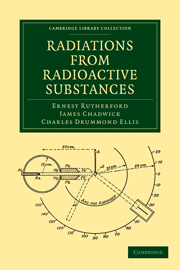Book contents
- Frontmatter
- Contents
- LIST OF PLATES
- Preface
- Chap. I Radioactive Transformations
- Chap. II The α Rays
- Chap. III Absorption of the α Rays
- Chap. IV Some Properties of the α Particle
- Chap. V Theories of Absorption of α Rays
- Chap. VI Secondary Effects produced by α Rays
- Chap. VII General Properties of the Radiations
- Chap. VIII The Scattering of α and β Particles
- Chap. IX The Collisions of α Particles with Light Atoms
- Chap. X The Artificial Disintegration of the Light Elements
- Chap. XI The Radioactive Nuclei
- Chap. XII β Ray and γ Ray Spectra
- Chap. XIII The Disintegration Electrons
- Chap. XIV The Passage of β Particles through Matter
- Chap. XV The Scattering and Absorption of γ Rays
- Chap. XVI Intensity Problems connected with the Emission of γ Rays
- Chap. XVII Atomic Nuclei
- Chap. XVIII Miscellaneous
- Appendix
- Subject Index
- Index of Names
- Plate section
Chap. I - Radioactive Transformations
Published online by Cambridge University Press: 07 September 2010
- Frontmatter
- Contents
- LIST OF PLATES
- Preface
- Chap. I Radioactive Transformations
- Chap. II The α Rays
- Chap. III Absorption of the α Rays
- Chap. IV Some Properties of the α Particle
- Chap. V Theories of Absorption of α Rays
- Chap. VI Secondary Effects produced by α Rays
- Chap. VII General Properties of the Radiations
- Chap. VIII The Scattering of α and β Particles
- Chap. IX The Collisions of α Particles with Light Atoms
- Chap. X The Artificial Disintegration of the Light Elements
- Chap. XI The Radioactive Nuclei
- Chap. XII β Ray and γ Ray Spectra
- Chap. XIII The Disintegration Electrons
- Chap. XIV The Passage of β Particles through Matter
- Chap. XV The Scattering and Absorption of γ Rays
- Chap. XVI Intensity Problems connected with the Emission of γ Rays
- Chap. XVII Atomic Nuclei
- Chap. XVIII Miscellaneous
- Appendix
- Subject Index
- Index of Names
- Plate section
Summary
§ 1. In studying the history of the rapid progress in our knowledge of atomic physics during the past thirty years, one cannot fail to be impressed with the outstanding importance of three fundamental discoveries which followed one another in rapid succession at the close of the last century. We refer to the discovery of the X rays by Röntgen in 1895, the discovery of the radioactivity of uranium by Becquerel early in 1896, and the proof of the independent existence of the negative electron in 1897 by Sir J. J. Thomson, Wiechert and Kaufmann. In a sense these discoveries mark the beginning of a new epoch in physics, for they provided new and powerful methods for attacking the fundamental problems of physics, such as the nature of electricity and the constitution and relation of the atoms of the elements. While the rapid development of pur knowledge in each of these new fields of enquiry has provided us with new and very valuable information on the nature of radiation and the interaction between radiation and matter, a new orientation of our views on this subject was given by the remarkable theory of quanta first put forward by Planck in 1900, although its full significance was not generally recognised for another decade. The application in 1913 by Bohr of the quantum theory to explain the origin of spectra and the arrangement of the electrons in the outer structure of the atom has proved of great significance to modern science.
- Type
- Chapter
- Information
- Radiations from Radioactive Substances , pp. 1 - 37Publisher: Cambridge University PressPrint publication year: 2010First published in: 1930

